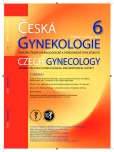Monochorionic biamniotic twins with a common yolk sac in the first trimester ultrasound scan – is there a higher risk of a congenital defect?
Authors:
M. Poláková 1
; L. Zetová 1; R. Vlk 2; Š. Vejvalková 3
Authors‘ workplace:
GEST IVF, Centrum reprodukční medicíny, Praha, vedoucí MUDr. J. Šulc a MUDr. M. Čekal
1; Gynekologicko-porodnická klinika 2. LF UK a FN Motol, Praha, přednosta prof. MUDr. L. Rob, CSc.
2; Ústav lékařské biologie a genetiky 2. LF UK a FN Motol, Praha, přednosta prof. MUDr. M. Macek, DrSc.
3
Published in:
Ceska Gynekol 2012; 77(6): 521-523
Overview
Type of study:
Case report.
Setting:
GEST IVF, Centre of Reproductive Medicine, Prague.
Methods:
The case report describes pregnancy after IVF + ET. The first trimester ultrasound scan showed monochorionic biamniotic twins with one common yolk sac (YS) only, which is possible in biamniotic twins, but very rare. Identical congenital defects such as anal, coccygeal atresia, and others, were diagnosed prenatally and postnatally in both twins.
Conclusion:
Yolk sac number in monochorionic twins can play an importart role in embryogenesi. Any possible relation with certain congenital defects has not yet been described. It is necessary to describe more cases.
Key words:
multiple pregnancy, monochorionic twins, yolk sac number.
Sources
1. Alen, VM., et al. Management of monoamniotic twin pregnancies: a case series and systematic review of the literature. BJOG, 2001, 108, 9, p. 931–936.
2. Bishop, DK. Yolk-sac number in monoamniotic twins. Obstet Gynecol, 2010, 116, Suppl. 2.
3. Bromley, B. Using the number of yolk sacs to determine amnionicity in early first trimester monochorionic twins. J Ultrasound Med, 1995, 14, 6, p. 415–419.
4. Demaria, F., Goffinet, F., Kayem, G., et al. Monoamniotic twin pregnancies: antenatal management and perinatal results od 19 consecutive cases. BJOG, 2004, 111, 1, p. 22–26.
5. Hulvert, J., Mardešič, T., Muller, P., et al. Monochoriální dvojčata po léčbě sterility metodami asistované reprodukce. Čes Gynek, 1999, 64, 5, p. 295–299.
6. Charles, A., et al. Diamniotic conjoined fetuses in a triplet pregnancy: an insight into embryonic topology. Pediatr Dev Pathol, 2005, 8, 6, p. 666–672.
7. Levi, CS., et al. Yolk sac number, size and morfologic features in monochorionic momoamniotic twin pregnancy. Can Assoc Radiol J, 1996, 47, 2, p. 98–100.
8. Malinowski, W. Yolk sacs in twin pregnancy. Ginekol Pol, 2000, 71, 8, p. 815–818.
9. Malinowski, W. Umbilical cord complications in twin pregnanties. Ginekol Pol, 2003, 74, 10, p. 1208–1212.
10. Moore, KL., Persaud, TVN. Zrození člověka – Embryologie s klinickým zaměřením. Praha: ISV, 2002.
11. Murakoshi, T., et al. Monochorionic monoamniotic twin pregnancies with two yolk sacs may not be a rare finding: a report of two cases. Ultrasound Obstet Gynecol, 2010, 36, 3, 384–386.
12. Shen, O., et al. Number of yolk sacs does not predict amnionicity in early first-trimester monochorionic multiple gestations. Ultrasond Obstet Gynecol, 2006, 27, p. 53–55.
Labels
Paediatric gynaecology Gynaecology and obstetrics Reproduction medicineArticle was published in
Czech Gynaecology

2012 Issue 6
Most read in this issue
- Monochorionic biamniotic twins with a common yolk sac in the first trimester ultrasound scan – is there a higher risk of a congenital defect?
- Homebirth in Czech Republic
- Conservative method in treatment of placenta accreta – two case reports
- Dehiscence of laparotomy after hysterectomy – wound management
